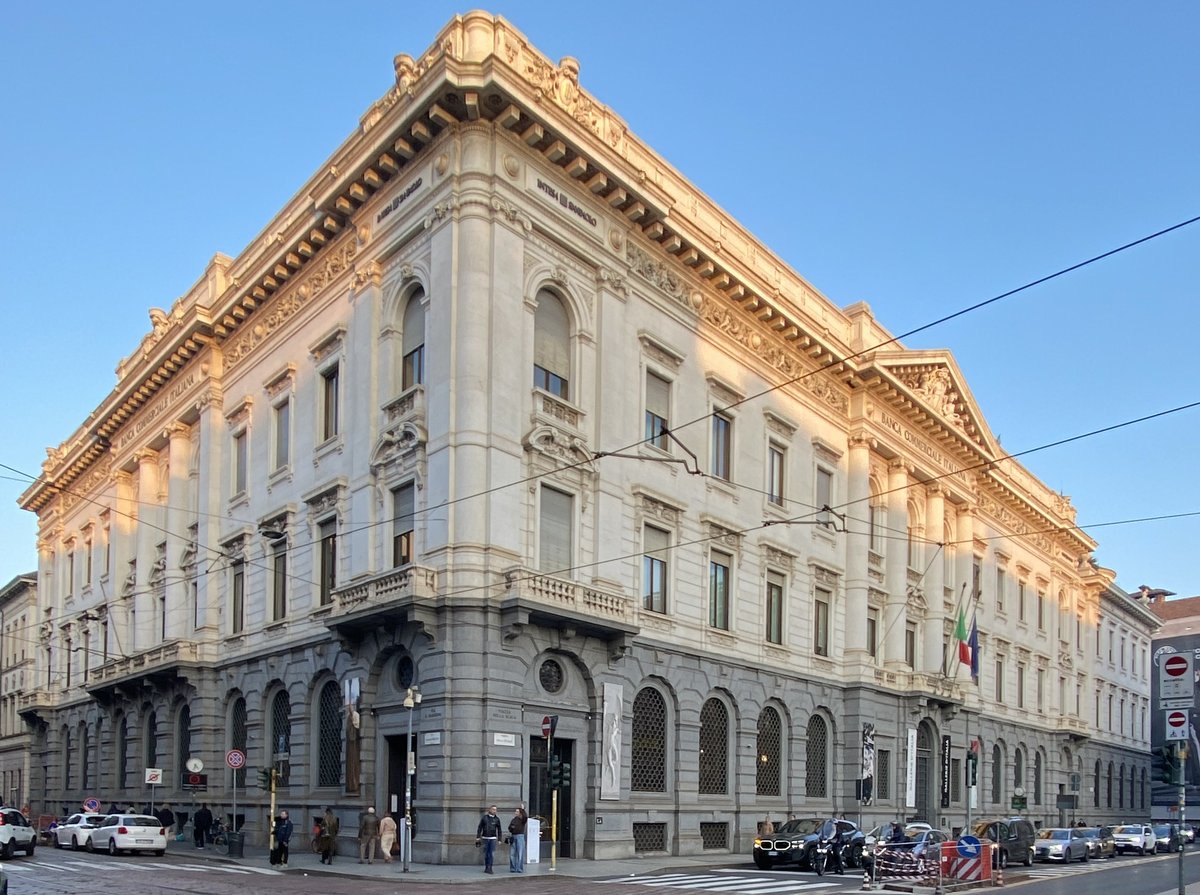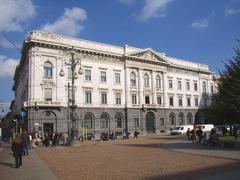
Palazzo della Banca Commerciale Italiana: Visiting Hours, Tickets, and Milan Historical Sites Guide
Date: 14/06/2025
Introduction
Situated in the heart of Milan’s historic center, the Palazzo della Banca Commerciale Italiana—also known as Palazzo Beltrami—exemplifies the city’s early 20th-century economic ascent and architectural splendor. Originally commissioned by the influential Banca Commerciale Italiana and designed by the renowned architect Luca Beltrami, the palazzo was completed in 1906 and stands in the prestigious Piazza della Scala, adjacent to cultural icons like Teatro alla Scala and the Galleria Vittorio Emanuele II. Today, it is not only a historical monument but also serves as a dynamic cultural venue as part of the Gallerie d’Italia museum complex, offering visitors a unique journey through Milan’s financial, architectural, and artistic heritage (terradimemorie.it, trek.zone, gallerieditalia.com).
This guide offers comprehensive insights into the palazzo’s origins, historical significance, architectural features, visitor information, and practical tips for exploring nearby Milanese landmarks.
Historical Overview
Origins and Construction
The Palazzo della Banca Commerciale Italiana was conceived at the dawn of the 20th century, symbolizing Milan’s emergence as Italy’s financial powerhouse. Commissioned by the Banca Commerciale Italiana (Comit), the building was designed by Luca Beltrami, a key figure in Milanese architecture, also noted for his restoration of the Castello Sforzesco. Completed in 1906, the palazzo’s monumental neoclassical façade, with its grand columns and ornate reliefs, was intended to convey strength, stability, and modernity—core values for a leading bank at the time (terradimemorie.it, trek.zone).
The Comit’s Role in Italian Economic History
Founded in 1894, Banca Commerciale Italiana rapidly became a central player in Italy’s industrial expansion, financing key sectors and attracting a cadre of intellectuals and professionals. Under leaders like Giuseppe Toeplitz, the bank fostered an environment that blended economic innovation with cultural and political engagement, and the palazzo became a hub for strategic decision-making during critical periods in Italian history (terradimemorie.it).
The Palazzo During the Fascist Era and WWII
During the Fascist regime and World War II, the palazzo played a pivotal, albeit discreet, role in anti-fascist resistance. The third-floor Ufficio Studi became a meeting point for intellectuals such as Raffaele Mattioli, Ugo La Malfa, and Sergio Solmi, and was instrumental in the clandestine founding of the Partito d’Azione. Remarkably, the building survived wartime bombings, allowing the bank and its covert activities to persist (terradimemorie.it).
Postwar Transformation and Cultural Renaissance
After the war, the palazzo remained a financial hub before being integrated into Banca Intesa and, subsequently, Intesa Sanpaolo. In 2011, a new chapter began as the building was transformed into part of the Gallerie d’Italia museum complex, opening its doors to the public and housing significant collections of Italian art from the 19th and 20th centuries (gallerieditalia.com).
Architectural Highlights
Exterior and Urban Context
Located at the heart of Piazza della Scala, the palazzo’s neoclassical façade is adorned with monumental columns and sculpted pediments, harmonizing with neighboring icons like the Teatro alla Scala and Palazzo Marino (Greta’s Travels). Its strategic positioning underscores its historical status as a symbol of Milanese prestige and civic pride.
Interior Features and Adaptive Reuse
The palazzo’s interiors are defined by majestic banking halls, intricate marble floors, and ornate ceilings. The recent restoration, led by architect Michele De Lucchi, has preserved these historic elements while upgrading accessibility and museum infrastructure, ensuring a seamless blend of heritage and contemporary functionality (Financial Times). A particular highlight is “The Caveau”—the former bank vault—now a secure exhibition gallery accessible during special guided tours (Milano Weekend).
Architectural Significance
The palazzo set a precedent for integrating monumental architecture within Milan’s urban core. Its combination of neoclassical motifs and modern construction techniques influenced subsequent developments and remains a model for adaptive reuse in the city (Financial Times).
Visitor Information
Location and Getting There
- Address: Piazza della Scala, 6, Milan.
- Metro: Duomo (M1, M3) and Montenapoleone (M3) stations are a short walk away.
- Tram/Bus: Tram lines 1 and 3 (stop: Scala); bus lines 61 and 94 serve the area.
- Walking: The palazzo is easily accessible on foot from Milan’s central landmarks (Evendo).
Opening Hours
- Gallerie d’Italia Museum: Open Tuesday–Sunday, 9:30 AM–7:30 PM (extended to 10:30 PM on Thursdays); closed on Mondays. Check the official website for seasonal changes or special holiday hours.
Tickets
- Admission: General tickets range from €10–€15. Discounts for students, seniors, and groups; free for under-18s and select categories. Special discounts and free entry days—such as the first Sunday of each month—may apply (Gallerie d’Italia).
- Advance Booking: Recommended via the official website to avoid queues.
Accessibility
- The building is fully wheelchair accessible, with ramps, elevators, and accessible restrooms. Assistance for visitors with sensory or cognitive disabilities is available on request.
Guided Tours & Virtual Visits
- Guided tours in multiple languages are available and can be booked in advance. Special tours include access to “The Caveau” vault. Virtual tours and online exhibits are also offered (Gallerie d’Italia).
Amenities
- Café & Restaurant: Enjoy Italian cuisine at VÒCE, operated by the Aimo e Nadia group.
- Bookshop: Offers a curated selection of art books and merchandise.
Museum Collections and Cultural Highlights
Permanent Collections
- 19th Century Art: Masterpieces by Canova, Segantini, Previati, and others (Neiade).
- 20th Century Art (“Cantiere del ‘900”): Works by Boccioni, Fontana, and key Italian modernists.
- The Caveau: A rotating selection from the Intesa Sanpaolo collection, viewable through guided tours.
Temporary Exhibitions and Events
- The Gallerie d’Italia regularly hosts high-profile temporary exhibitions and cultural initiatives, including collaborations with international institutions (Gallerie d’Italia).
Exploring the Surroundings
Nearby Historical Sites
- Teatro alla Scala: Renowned opera house with museum tours.
- Galleria Vittorio Emanuele II: Iconic shopping arcade.
- Piazza del Duomo: The city’s Gothic cathedral is a short walk away.
- Brera District: Artistic neighborhood with galleries and boutiques (The Travel Folk).
Dining & Shopping
- Elegant cafés and restaurants are plentiful in the piazza and Galleria. For luxury shopping, Via Monte Napoleone and the Galleria host top fashion brands (ReadySetItaly).
Practical Tips
- Best Photo Opportunities: Early morning or late afternoon for natural light; evening for the illuminated façade.
- Accessibility: The piazza is flat and pedestrian-friendly; public transport is equipped for mobility needs.
- Safety: The city center is generally safe, but remain vigilant with belongings in crowded areas.
- Restrooms & Wi-Fi: Facilities are available in the Galleria and cafés; free Wi-Fi in many public areas.
- Event Access: Interior access to the palazzo outside museum hours is limited to special events or exhibitions—check local calendars for updates (Evendo).
Frequently Asked Questions (FAQ)
Q: Can I enter the palazzo’s historic interiors?
A: Regular access is via the Gallerie d’Italia museum. Additional interior access is sometimes available during special events or guided tours.
Q: What are the Gallerie d’Italia’s visiting hours?
A: Tuesday–Sunday 9:30 AM–7:30 PM; Thursday open until 10:30 PM; closed Mondays.
Q: Are guided tours available?
A: Yes, in multiple languages, with special tours to the former bank vault.
Q: Is the museum wheelchair accessible?
A: Fully accessible, with facilities and support for all needs.
Q: How do I find out about special events or exhibitions?
A: Check the Gallerie d’Italia website or local event listings.
Conclusion
The Palazzo della Banca Commerciale Italiana is a cornerstone of Milan’s urban and cultural landscape, embodying the city’s financial history, architectural innovation, and commitment to heritage preservation. Its transformation into the Gallerie d’Italia museum has breathed new life into this historic landmark, offering visitors the chance to explore both its artistic treasures and its storied past. Whether you are passionate about architecture, Italian art, or Milanese history, a visit to this palazzo—and its surrounding attractions—will enrich your experience of the city.
Plan ahead by booking tickets online, checking current visiting hours, and exploring the vibrant neighborhood that surrounds this iconic site. For a deeper dive, download the Audiala app for guided tours, interactive maps, and the latest updates on Milan’s historical and cultural offerings.
Sources and Further Reading
- Visiting the Palazzo della Banca Commerciale Italiana in Milan: History, Tickets, and Travel Tips, 2024, Terradimemorie
- Palazzo Della Banca Commerciale Italiana in Milan: Visiting Hours, Tickets, and Architectural Highlights, 2024, Greta’s Travels
- Gallerie d’Italia Milan: Visiting Hours, Tickets, and Museum Guide, 2024, Gallerie d’Italia Official Website
- Palazzo della Banca Commerciale Italiana: Hours, Tickets, and Milan Historical Sites Guide, 2024, Evendo
- Milano da Vedere, 2024, Palazzo della Banca Commerciale Italiana
- Financial Times, 2024, Milan Architecture and Cultural Heritage
- The Travel Folk: 2 Days in Milan, Italy
- ReadySetItaly: Milan Travel Guide





























































